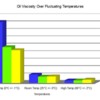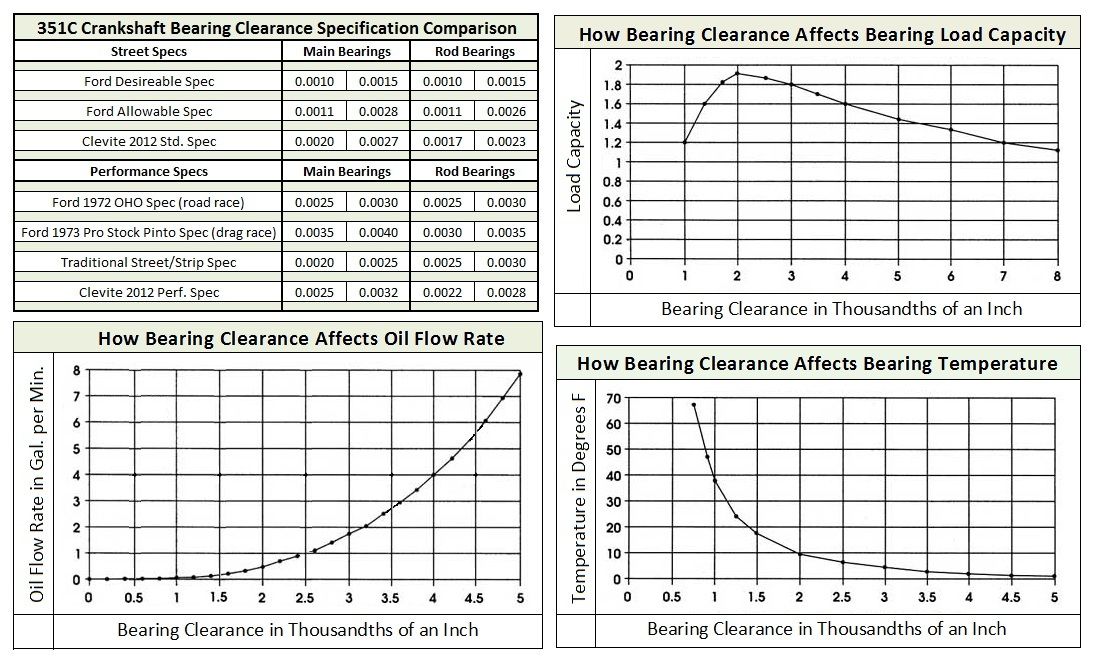Some guys swear by the "external oil line", they consider it a method for reducing the probability of rod bearing damage at high rpm that can be installed without tearing the motor apart. It boosts the sagging oil pressure in the right hand oil passage thereby increasing the amount of oil flowing to the 3 central main bearings and improving rod bearing lubrication, but it doesn't resolve the underlying issues. Cavitation within the right hand oil passage (caused by the tappets) is still there, its effects are merely diminished. Excessive oil leakage in the clearances between the tappets and tappet bores is not resolved either, the external hose serves to supply those leaks from a different direction. Finally there is no control of where the oil is flowing. For those reasons I consider the external oil line a temporary aid that can be installed without tearing the motor apart, but not a final solution.
Its best to understand the problem before attempting to fix it.
Design and Performance IssuesEvery way in which the 351C design deviated from the design of the SBF was to make an improvement, with one exception ... the lubrication system. The SBF utilized three lubrication passages; oil was supplied to the crankshaft main bearings first via a dedicated passage, then at the rear of the block the oil supply was split into two additional passages to supply the two banks of tappets; this is referred to as a main priority system. To save money the 351C was designed with only two lubrication passages, one for each bank of tappets. Lubrication for the crankshaft’s 3 central main bearings was supplied by branches intersecting the same oil passage shared by the right hand bank of tappets.
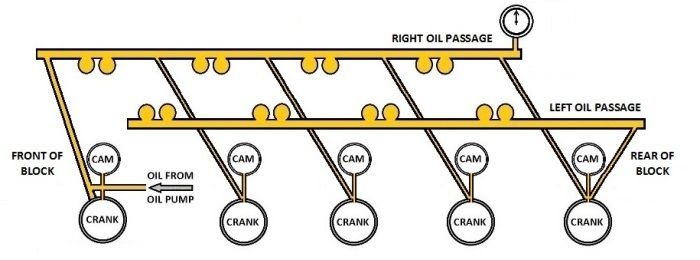
Ford found it necessary to redesign the tappets installed in the 351C due to the large port in the wall of each tappet bore, a result of the way in which the tappet bores intersect the oil passages. Tappets designed for the SBF and 351W allowed too much oil to flow to the 351C valve train. When a 351C equipped with the "wrong" tappets is operated at higher rpm the rocker covers flood with oil while the oil pan is slowly pumped dry at the same time. Thus the 351C has compatibility issues with tappets having certain types of oil metering designs; this also illustrates the importance of limiting the amount of oil flowing to the 351C valve train.
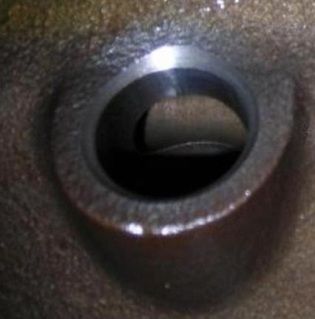
Lubrication system pressure is supposed to be controlled by a relief valve built into the 351C oil pump. The setting of the relief valve is controlled by a spring intended by the designers to maintain 60 psi nominal hot oil pressure (50 psi minimum and 70 psi maximum) but the 351C has a propensity for low oil pressure. Hot oil pressure below 50 psi indicates an excessive amount of oil is flowing into various "leaks and clearances”, overtaxing the capacity of the oil pump. The 351C also has a propensity for bearing wear. The symptoms of insufficient lubrication are evident even in low mileage engines; those symptoms include ribbons of bearing material lying in the bottom of the oil pan, scoring on the bearings, bearings being polished, or bearings worn so much they are no longer silver in color but copper colored. Obviously the excessive amount of oil flowing into various "leaks and clearances" is not flowing to the rod bearings!
A member of the Clevelands Forever forum had this to say:
quote:
I worked as a Ford dealership mechanic for 14 years, starting back in 1970. I replaced many main and rod bearings in the 351C and 400M engines. Those cars and pickup trucks were driven on the street and probably by older drivers. They didn't even have high miles and the engines were lucky to see 4000 RPM's. The mains and rods would become so worn, the oil pressure warning light would flicker on when the engine was hot, during idle and low RPM's. These engines were known for their oiling problems.
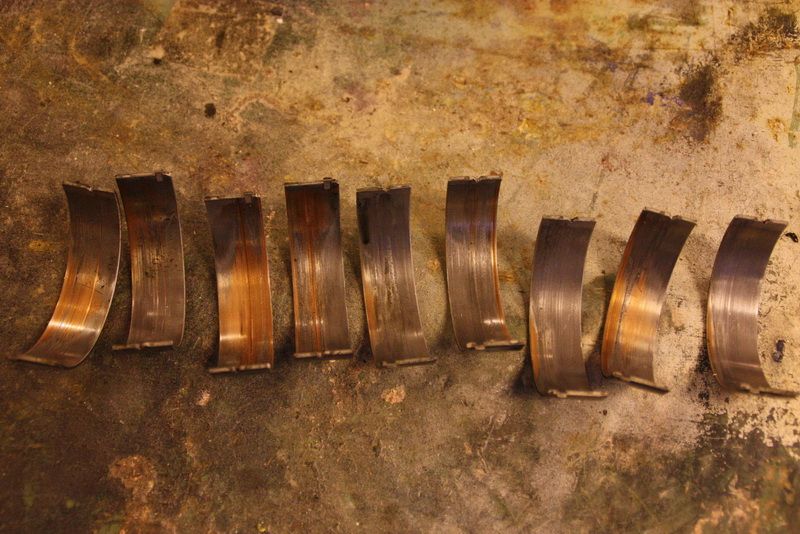
Photo courtesy of danishcarnut (aka Heine Hansen)
The two basic design flaws of the lubrication system are:
(1) There's no control of where the oil is flowing nor is there control of how much oil is flowing.
- Main bearing lubrication does not have priority or first claim to the oil discharged from the oil pump
- An excessive amount of oil flowing to waste in the tappet clearances reduces the amount of oil available for lubricating the crankshaft
- An excessive amount of oil flowing to the valve train or the camshaft bearings also reduces the amount of oil available for lubricating the crankshaft
(2) The large ports in the walls of the tappet bores create three additional problems.
- The ports allows too much oil to flow to waste
- The ports create tappet compatibility issues, possibly allowing too much oil to flow to the valve train
- The ports allow cavitation resulting from the motion of the tappets to spread within the oil passages.
People are under the assumption 351C lubrication problems occur predominantly above 7000 rpm, but cavitation does not turn off and on like a light switch at a specific engine speed. Cavitation increases gradually, becoming more severe as the speed of the tappets increases; cavitation is therefore impacting the oil passages to a lesser degree at engine speeds below 7000 rpm. Cavitation simply increases to the point of causing rod bearing failure at some point beyond 7000 rpm. But any amount of cavitation in the right hand oil passage shall impede the flow of oil to the crankshaft's 3 center main bearings to some degree.
There are those who insist the lubrication system is "good enough" up to 6000 rpm. Yet even low-mileage engines equipped with factory camshafts were plagued by low oil pressure and worn bearings. High lift rate camshafts and typical high mileage tappet bore wear worsen the problems. The lubrication system’s performance also worsens as engine speed increases; the performance diminishes to the point of rod bearing failure at some point beyond 7000 rpm. The bearings for connecting rods #2 through #7 are affected, but the bearings for connecting rod #2 or connecting rod #7 are usually the first to fail. All of the lubrication system problems impact solid tappet motors and hydraulic tappet motors equally. The symptoms are the same regardless if the rev limit is 5000 rpm, 6000 rpm, 7000 rpm or higher; the symptoms merely worsen as rpm increases. The consensus has always been that any 351C being rebuilt for any kind of performance application (from mild to wild) needs some improvement to the lubrication system.
History behind modifying the lubrication system for solid tappet motorsThe production oil pump is equipped with an oil pump spring rated for 50 to 70 psi. Ford's first "fix" for the lubrication system was introduced in 1972; it was a high pressure oil pump spring to boost the 351C oil pressure. Moroso still sells a similar spring. The spring is rated for 80 to 100 psi. The higher oil pressure did not resolve the problem however, connecting rod bearings were still under-lubricated. This is an important aspect to understand, it can't be repeated enough,
high oil pressure does not guarantee the 351C rod bearings are receiving adequate oil. The high pressure oil pump spring was not the solution Ford had assumed it would be, evidenced by the fact that the search for a solution continued.
Dyno Don Nicholson and other Pro Stock racers began installing tappet bore bushings in their pro stock Clevelands as early as 1973. The bushings quickly became standard in NASCAR engines too because stock car racing teams were gradually running their motors at higher and higher speeds. Ford quietly introduced a kit for installing bushings in the tappet bores about 1974; the kit also included restrictions for the cam bearing oil passages. These two corrective measures superseded the high pressure oil pump spring, they were, and shall always be Ford's successful remedies for the 351C lubrication system. A tappet bore bushing installation kit is available today from Wydendorf Machine.
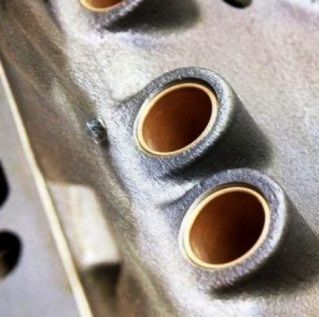
Ford never publicized the existence of the tappet bore bushing kit, it came on the scene after Ford had stopped publishing the OHO Parts Newsletter. The kit was sold "under the table" in an era when Ford was supposed to be out of racing and out of the performance parts business, therefore the existence of the kit was not well known to the general public.
Tappet bore bushings became the essential modification for solid tappet motors to prevent rod bearing damage. Some folks used Ford’s bushing kit even though it was very expensive, some folks manufactured their own tools for installing the bushings (by copying Ford's tools), others relied on a machine shop to install them. The four modifications listed below became common for solid tappet motors to prevent rod-bearing under-lubrication:
(1) The main bearing and rod bearing clearances were increased (see note below)
(2) Clevite 77 bearings were installed, which included fully grooved main bearings.
(3) Cam bearing oil passage restrictions were installed
(4) Tappet bore bushings were installed
Note: In case you are curious, the bearing clearances in common use were:
- Main bearing street: 0.0020" to 0.0025" (0.0008" to 0.0009" clearance per inch of main bearing journal diameter)
- Main bearing race: 0.0025" to 0.0030" (0.0009" to 0.0011" clearance per inch of main bearing journal diameter)
- Rod bearing street or race: 0.0025" to 0.0030" (0.0011" to 0.0013" clearance per inch of rod bearing journal diameter)
Hank Bechtloff (i.e. Hank the Crank) offered an elaborate lubrication manifold system for modifying the 351C lubrication system beginning 1974 that was promoted by Hot Rod Magazine every time they ran a story about the 351C. The gentleman who designed the lubrication manifold system informed me he designed the lubrication manifold because he was opposed to the installation of bushings in the tappet bores for fear they would restrict the amount of oil flowing in the right hand lubrication passage. What is not widely know is that the Hank the Crank 351C lubrication manifold didn’t work as designed in every application; some race teams using his lubrication manifold still experienced bearing failure. The gentleman who designed the lubrication manifold believed the failures stemmed from the fact the manifold's installation was too complicated and the system was re-engineered a few times in an attempt to resolve the installation problems. The Hank the Crank lubrication manifold developed a poor reputation, even the designer gave-up on it. The designer candidly informed me he resorted to making unspecified "internal" modifications to his personal 351C engines. The majority of racing teams standardized on use of tappet bore bushings in the 351C.
Installation of tappet bore bushings is still a standard step taken by old-time 351C mechanics, racers and enthusiasts even today.
Some folks connect the plugged oil passage near the oil filter with the oil pressure port at the rear of the engine block via an "external oil line"; this routes oil discharged from the oil pump directly into the rear of the right hand oil passage. It is a method for reducing the probability of rod bearing damage at high rpm which can be installed without tearing the motor apart. That is the main attraction of this modification. It does indeed boost the sagging oil pressure in the right hand oil passage caused by cavitation; therefore it increases the amount of oil flowing to the 3 central main bearings and improves rod bearing lubrication. Cavitation within the right hand oil passage (caused by the tappets) is still occurring however, its effects are merely diminished. Excessive oil leakage in the clearances between the tappets and tappet bores is not resolved either, in fact the external oil line may increase the amount of oil flowing to waste in the tappet clearances. Finally there is no control of where the oil is flowing nor how much oil is flowing. For those reasons the external oil line is at best a temporary measure for protecting the rod bearings, but it is not a permanent solution; it is not a replacement for tappet bore bushings.
History behind modifying the lubrication system for hydraulic tappet motorsSince the typical street performance motor with hydraulic tappets only revved up to 6500 rpm or less nobody believed they required tappet bore bushings. Tappet bore bushings were considered too expensive for a typical street engine project; it is true Ford's bushing kit was very expensive, and some machine shops charged a lot to install them too (that argument is not valid today however because the tappet bore bushing kit sold by Wydendorf Machine is reasonably priced). The general consensus was that any 351C being rebuilt for any kind of performance application (from mild to wild) needed some improvement to the lubrication system however to achieve 60 psi hot oil pressure, to control the amount oil flowing to the valve train, and to hopefully prevent rod bearing wear or damage. So Forty years ago there were two schools of thought regarding modifying the 351C lubrication system for hydraulic tappet street motors:
(1) One school of thought adhered to the advice given by Jack Roush in Hot Rod magazine (1973, 1976). Jack Roush recommended a standard volume oil pump, the Moroso high pressure oil pump spring and the Moroso cam bearing restriction kit including the 0.080" restrictor for the left hand oil passage. Bearing clearances were 0.0020" to 0.0025" for the main bearings and 0.0025" to 0.0030" for the rod bearings. TRW (Clevite) bearings were recommended, which meant the motor was equipped with fully grooved main bearings, because fully grooved main bearings were a standard feature of Clevite bearing kits for the 351C. The motor’s cold start oil pressure ran about 120 psi with the high pressure oil pump relief spring installed, enough to burst an oil filter canister if the driver inadvertently blipped the throttle when the oil was cold, as many guys found out the hard way. A Motorcraft high pressure oil filter # FL-1HP was needed if the high pressure spring was installed. Notice the only measure taken to control the amount of oil flowing to the valve train was the 0.080" restrictor for the left hand bank of tappets.
(2) The second school of thought utilized a high volume oil pump to boost oil pressure and to hopefully deliver more oil to the rod bearings which had the clearances increased to 0.0025" to 0.0030" (in conjunction with main bearing clearances increased to 0.0020" to 0.0025"). TRW (Clevite) bearings were again recommended, which meant the motor was equipped with fully grooved main bearings; the purpose of fully grooved main bearings is to supply more oil to the rod bearings by supplying oil to the rods through 360 degrees of crankshaft rotation. Installation of a high volume oil pump alone without taking any measures to control where the extra oil was flowing would also supply more oil to the camshaft bearings and the valve train. So to control the amount of oil flowing to the camshaft bearings the small restrictions from the Moroso cam bearing restriction kit were installed, and push rods having restrictions in the tips or thick wall 5/16” OD push rods with 0.072” passages through the middle were installed to control the amount of oil flowing to the valve train. In this way the extra oil supplied by the high volume oil pump was routed as best as possible to the rod bearings where the clearances had been increased. This lubrication scheme was mentioned in a Hot Rod magazine story about a 351C build-up by Ron Miller (1985).
ConfusionThe lubrication system problems and their solutions should have been clearly stated and well publicized but Ford stopped publishing the OHO Parts Newsletter in early 1973, just as the solution was being discovered. Ford entered an era (1973 - 1982) when it was officially out of racing and out of the performance parts business. During that era information was spread word-of-mouth via the grass-roots network of Ford performance shops.
This issue was also confused by a couple of popular publications. Jack Roush claimed in print the only lubrication system preparation his shop performed on their Pro Stock motors was to install the Moroso cam bearing restriction kit and the Ford - Moroso high pressure oil pump spring (Hot Rod Magazine 1973, 1976). Those who raced Pro-Stock in that era roll their eyes at that claim. It should be obvious to you by now that it requires more than that to resolve the problems with the 351C lubrication system.
The Ford Performance book by Pat Ganahl (published in 1979) has been used as a Ford performance information source for decades. Its an admirable book in many ways, and a wonderful document any automotive author could be proud of. Its helped and informed a lot of people over the decades. In the Cleveland chapter the book mentioned the tappet bore bushings in some detail, but only in the context of pro-stock drag racing engines. In the miscellaneous section the book mentioned using a high volume oil pump, then immediately contradicts that recommendation noting Jack Roush recommends the standard volume pump and a high pressure oil pump spring. In the building tips section the book quoted the Pro Stock Pinto book (published by Ford in 1972) regarding the lubrication system, referring to it as an indirect factory information source. That quote states no modification is recommended other than a deep sump oil pan and the high pressure oil pump spring. Of course I've already explained that boosting oil pressure with the high pressure spring (introduced in 1972) didn't fix the lubrication system. In citing that quote from the Pro Stock Pinto book Pat Ganahl's book perpetuated old, ineffective, erroneous information. The book then contradicts that quote by recommending additional modifications including the Moroso oil passage restrictor kit, oil metering tappets, and oil restricting push rods. The subject is closed by recommending that the tappet bores are checked for wear, but doesn't mention how much wear is acceptable or what to do if wear is found. In other words, the book mentioned a little bit of everything, contradicted itself twice, but offered no concise guidance. The Ford Performance book has many fine qualities, but the guidance provided regarding the 351C lubrication system is not its best feature.
Concise GuidanceImprovements to the 351C lubrication system should focus upon correcting the design flaws rather than the symptoms. One corrective action would be to modify the lubrication system to better control where oil is flowing and to better control how much oil is flowing. We can both minimize the excessive amount of oil flowing to waste via the tappet clearances and limit the amount of oil flowing to the valve train by installing 16 tappet bore bushings. We can also limit the amount of oil flowing to the camshaft bearings by installing 5 cam bearing oil passage restrictors. If we allow oil to flow unrestricted to the crankshaft after making those modifications we are essentially giving lubrication of the crankshaft priority, i.e. we've succeeded in modifying the 351C lubrication system to behave as a main priority system. Thus modified there is plenty of oil volume even with the standard volume oil pump, the standard oil pump spring shall operate in the middle of its range and control oil pressure at about 60 psi in the manner it was originally intended to do, and the quantity of motor oil flowing to the crankshaft shall be substantially increased at all engine speeds, even low rpm!
The tappet bore bushings also correct the other design flaw; they eliminate the large ports in the walls of the tappet bores, metering oil to the tappets via small orifices instead. This isolates the oil passages from the motion of the tappets thus eliminating cavitation in the oil passages; this is another vital step in making it possible for oil to flow unimpeded to the central 3 main bearings. The tappet bore bushings also resolve tappet compatibility issues.
The reasonably priced do-it-yourself tappet bore bushing installation kit available from Wydendorf Machine (selling for $400 USD) makes all of this affordable and within the budgets of a large range of engine projects.
Wydendorf Machine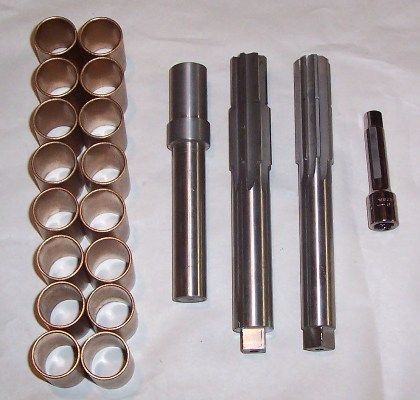
Four decades ago only eight bushings were installed in the right hand tappet bores, but it is customary these days to install bushings in all sixteen tappet bores. The reasons for this are to insure consistent oil control at all sixteen valves, to perform optimally with hydraulic tappets, and to resolve 351C tappet compatibility issues. The tappet bore bushings remove the task of oil metering from the tappets or push rods, and they make the 351C more tolerant of which type of tappet is installed.
My preference is to drill the bushings with 0.060" (or 1/16") orifices for all hydraulic tappet applications, all street and sports car applications, and all road racing, circuit racing and endurance racing applications because once the bushings are pressed into the block the orifice size can't be changed. The 0.060" orifices are a good size for a general purpose or "do-it-all" type of engine set-up. I would suggest this size orifice for dirt track and street/strip applications too.
Four decades ago four restrictors were installed in the passages supplying oil to cam bearings #2 through #5, but it is customary these days to install restrictors in all five cam bearing oil passages. Experience has proven an oil passage restrictor for cam bearing #1 improves the performance of the lubrication system, therefore it is assumed the oil passage for cam bearing #1 diverts a significant amount of oil from the main oil passage which it intersects. Acquiring five camshaft bearing restrictors shall require purchasing two Moroso #22050 restrictor kits, because each kit only has four cam bearing restrictors. The restrictor for cam bearing #1 is installed in a different manner than the restrictors for the other four cam bearings; it must be installed more deeply within the cam bearing oil passage so that it restricts oil to the #1 cam bearing and not to the #1 main bearing. The large restrictors included in the Moroso kits are not used.
My thoughts for preparing a performance engine without tappet bore bushingsAny performance motor being assembled without tappet bore bushings should be set-up to achieve 60 psi hot oil pressure by 2000 rpm (as per Ford spec). Ideally this would be accomplished by reducing the amount of oil flowing to waste, and metering the amount of oil flowing to the valve train and camshaft bearings, thus (hopefully) allowing the factory oil pump equipped with the factory oil pressure spring to operate in the middle of its control range.
In reality you will not achieve that goal without the tappet bore bushings. But to proceed with the idea of building a "performance" motor without tappet bore bushings, here are four considerations:
(1)
Tappet to tappet bore clearances: Leakage of motor oil in the tappet to tappet bore clearance impacts the 351C so severely that I wouldn't build a performance motor with tappet to tappet bore clearances greater than 0.0017", which was the nominal factory clearance of a new motor. Tappet clearance is a measurement often neglected by enthusiasts when rebuilding a motor, but with a 351C its a step that can't be ignored. To make these measurements you're going to need the tools for making some very precise measurements, down to 1/10,000 of an inch. It shall be critical to check the tappet bores for being out-of-round.
The factory tolerance for tappet to tappet bore clearance is 0.0007” to 0.0027", the nominal clearance therefore is 0.0017". The production specification for tappet OD is 0.8740” to 0.8745”. The production tolerance for the tappet bore ID is 0.8752” to 0.8767”. If a tappet with the minimum OD (0.8740”) is installed in a tappet bore with the largest allowable production ID (0.8767”) the clearance is 0.0027” which is greater than the clearance between the crankshaft bearing journals and the bearings! More oil would flow to this “leak” than would flow to the bearing journals! If a block has worn or egg shaped tappet bores the nominal clearances will be greater yet. If the tappet bores are out-of-round they will have to be corrected to minimize oil leakage in the tappet clearance and to achieve adequate oil pressure. Installation of tappet bore bushings is the best method for repairing worn tappet bores, but another possible method for repairing them would be to acquire a set of oversize tappets from a tappet manufacturer and then hand fit the tappet bores for 0.0007" clearance.
(2)
Metering oil to the valve train: Anyone assembling a performance motor without tappet bore bushings must take alternative steps in order to meter the quantity of oil flowing to the valve train. Solid flat tappet engines accomplish this via the tappets. SEC/Johnson was the original manufacturer of the Boss 351 oil metering plate solid flat tappet. That tappet is available from Speed Pro under part number AT2000 and available from Crower Cams under part number 66915X980-16P. This tappet will meter oil to the valve train properly without any other aid. Do not use edge-orifice tappets. Solid roller tappets MUST use tappet bore bushings.
Metering oil to the valve train is accomplished in hydraulic tappet engines via the push rods. The oil metering of any hydraulic tappet (flat or roller) should be augmented by employing push rods with 0.040" restrictors in the tips or utilizing 5/16" OD push rods manufactured from 0.116" to 0.120" wall thickness tubing. The oil passage in the middle of those super-thick-wall 5/16" push rods is so small it serves as a good restriction to oil flow. The best hydraulic flat tappet for the 351C is Speed Pro's part number HT900 tappet which is manufactured by SEC/Johnson. The anti-pump-up version of that tappet is part number HT900R. The best hydraulic roller tappet is the Crane Cams tappet.
(3)
Metering oil to the camshaft bearings: Oil flowing to the camshaft bearings must also be metered, therefore oil passage restrictions for all 5 camshaft bearings should be installed whether or not tappet bore bushings are installed.
(4)
Which oil pump? Even after performing these steps some enthusiasts like to shim the standard oil pump spring with a 1/8" or 3/16" thick washer; because they've found it necessary to do so in order to achieve 60 psi hot oil pressure. Others opt to use a high volume oil pump for the same reason. I used to use the Moroso high pressure spring for this purpose, but I've changed my mind about using that spring. Theoretically the motor requires additional oil volume, the pressure is low because the capacity of the oil pump is being over-taxed. BUT there's no guarantee all that additional oil volume isn't going to go straight to waste in the tappet to tappet bore clearances and provide exactly zero benefit for the engine. Making the lubrication system truly work well (lubricate the crank bearings adequately) without tappet bore bushings is like banging your head against a wall.
The path to follow should be very obvious, or at least I believe it is. I do not understand the resistance the subject of tappet bore bushings receives. Installing them is not destructive to the engine, and thanks to Mr. Wydendorf's kit it can be done at home for a reasonable price. I've seen people spend more money on a set of valve covers! My best advice is to employ the tappet bore bushings and the standard pump. That allows the lubrication system to operate as the designers intended.
-G







